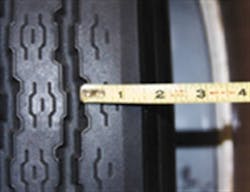Strictly taboo: Some truck tire injuries aren't repairable
Knowing which medium and heavy truck tire injuries can and cannot be repaired ensures customer satisfaction, minimizes expensive comebacks and, in many cases, protects dealers from possible tire failure-driven lawsuits. What injuries are beyond salvage? Modern Tire Dealer posed the question to several industry-renowned tire repair experts. Here are there answers:
Repair no-no's
You cannot perform a nail hole repair outside a tire's crown area, says Kevin Rohlwing, director of training for the International Tire & Rubber Association (ITRA). The crown is defined as "anywhere from an inch to an inch-and-a-half from either shoulder - basically, the center of the truck tire (see photo). Anything outside the crown area, including all injuries to the shoulder and sidewall, are considered section repairs."
Injuries that occur near belt edges also should be treated as section repairs. "Belt edges are very sensitive," Rohlwing says. "Any damage that isn't properly removed can contribute to belt separation."
Sidewall injuries must not exceed one-and-a-half inches in width by 3 and 1/8-inches in length. The width measurement is always taken by measuring in the running direction of the tire, says Bill Johnson, director of worldwide training for Tech International. "The length is measured from bead to bead."
Any tire with an injury exceeding one-and-a-half inches in width should be taken off the highway and downgraded to yard tractor or pick-up and delivery applications, Johnson says. "These operations place less stress on the tire." Also, never exceed two section repairs per tire for line-haul operations.
Injuries within 2.5 inches of the bead area should not be fixed, according to Jerry Davis, director of retreading and heavy materials for 31 Inc. You can try, "but the tire will flex and torque and, running under heat build-up, eventually explode. These types of failures tend to be catastrophic, leading to possible loss of vehicle control."
Tires that exhibit bead area damage should be scrapped, he says. And trying to fix separations is a "no-no," though the practice was more common during the days of bias-ply truck tires. "Radials are less forgiving. You have to understand what you're doing when you're working with them."
By the book
Use extreme caution when fixing medium and heavy commercial truck tires. Always plug and patch using a rubber stem and repair unit, according to Rohlwing. "I don't care if it's a 1/16-inch finishing nail in the center of the tread. There's no exception."
Follow tiremakers' guidelines when fixing tires, he says. "The tire manufacturer determines a tire's repair limits. They make the rules."
Also heed instructions provided by tire repair material manufacturers. “All tire repair material manufacturers publish charts that basically state, 'for an injury of this size, this is the patch you should use,'" says Jeff Young, national sales manager for Patch Rubber Co. "They're constantly reviewed and updated as tires and patches change."
It's tempting to improvise out in the field, he says. "But if you do it wrong, there's a good chance of failure. There's a procedure and a reason for what we do to ensure that a tire performs the way it should."
